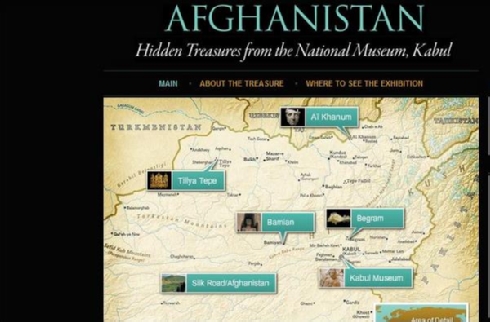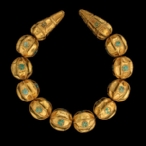Exhibition Layout & Object Highlights
The exhibition will begin with a new map of modem Afghanistan created by National Geographic, which highlights the four archaeological sites featured in the show. Specially commissioned maps will be on display throughout the exhibition, including one that illustrates more than 1,500 archaeological sites, known to be in Afghanistan, which range in date from the prehistoric era through the 17th century. The exhibition is organized by site, beginning with objects from Tepe Fullol in northern Afghanistan. ln 1966, farmers near the Afghan village of Fullol discovered the first evidence of a Bronze Age civilization in the region. Gold from the nearby Oxus riverbed most likely provided the gold for several bowIs- part of a burial cache - found at the site, including a fragment of a bowl depicting bearded bulls from 2200 to 1900 BC.
The second group of artifacts, from the site of the former Greek city Ai` Khanum in a region that was conquered by Alexander the Great, reflects the Mediterranean influence in the area between the fourth and second centuries BC. The works include Corinthian capitals from before 145 BC, similar to one shown to the late Afghan King Zahir Shah in 1961, which led to the discovery of the site of Ai Khanum. They also include bronze and ivory sculptures representing Greek figures, as well as images of Central Asian figures carved in a Hellenistic style. The oldest artifact found is a ceremonial plaque made of gilded silver depicting Cybele, the Greek goddess of nature presiding within an orderly cosmos. There will be a digital reconstruction of the city of A`i Khanum as well as a site map. Items of trade from the third site, at Begram, date from between the first and second centuries AD.
Elaborately carved Indian ivory reliefs and figurines used as decorative elements on furniture will be digitally reconstructed and shown on a monitor in the gallery with a site map of Begram. A painted goblet depicting figures harvesting dates and a bronze mask of Silenus are just a few of the artifacts discovered that shed light on the role of Afghanistan in the network of trade along the Silk Road.
The graves contained thousands of gold objects sewn onto the burial shrouds and clothing of the deceased. On view will be an exquisite crown, as well as necklaces, belts, rings, and headdresses-most made of solid gold with insets of semiprecious stones such as turquoise and garnets. Many of the Bactrian objects reflect local artisans’ distinctive blend of motifs known from Greek, Roman, Indian, and Chinese art.











